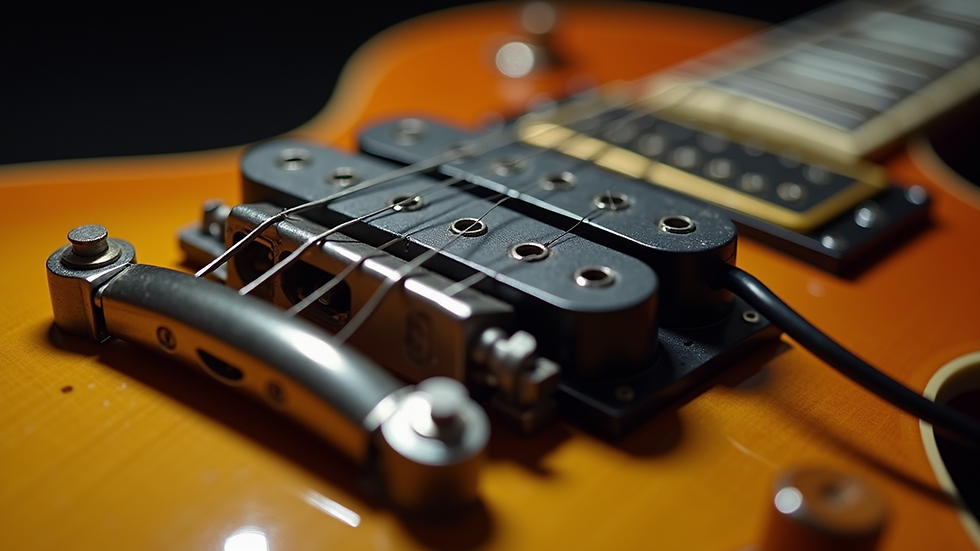How to Transform Your Gibson Les Paul Guitar by Replacing Double Humbucker Pickups Like a Pro
- connorsmontgomery0
- May 28
- 5 min read
Upgrading the pickups on your Gibson Les Paul can greatly enhance your sound, helping you achieve the perfect tone you've always wanted. Whether you're aiming for a classic vintage sound or something more modern, replacing your double humbucker pickups is a great way to make your guitar truly yours. In this guide, we’ll walk you through the entire process. By the end, you'll feel confident tackling this project like a pro!
Understanding the Basics of Humbucker Pickups on a Guitar
Before diving into the replacement process, it's essential to understand what humbucker pickups are and how they affect your guitar’s tone.
Humbucker pickups consist of two coils that work together to cancel out noise and interference, resulting in a deep, rich sound. This makes them ideal for various musical genres, from rock to jazz. For instance, many rock musicians prefer humbuckers for their ability to produce a thick, full sound, while jazz guitarists appreciate the warm, smooth tones.
When choosing pickups, consider their output levels, sound clarity, and resistance to electromagnetic interference. For example, a high-output pickup may be great for hard rock styles, while a lower-output pickup could be better for clean, bluesy tones. Understanding these factors will help you choose pickups that fit your playing style perfectly.
Choosing the Right Pickups
With a grasp of how humbuckers function, it's time to select the right pickups for your Les Paul.
Research and Compare
Start by researching available brands and models. Companies like Seymour Duncan, DiMarzio, and Gibson offer a variety of options tailored for different styles. For example, the Seymour Duncan JB model is known for its versatility across genres, and it has a high output level—ideal for both classic rock and heavy metal.
Listening to sound samples on the manufacturer's websites or platforms like YouTube can provide crucial insights into each model's sound profile, helping you narrow down your options.
Consider Your Playing Style
Your playing style and the music genres you prefer should guide your pickup choice. Are you after a warm, bluesy sound, or do you want a brighter, more aggressive tone?
For example, if you mainly play heavy metal, you might want pickups like the EMG 81, which deliver powerful output and sustain. On the other hand, if you're more into classic rock and blues, you might prefer pickups like the Gibson Burstbucker, known for its low output and clarity.
Gathering Tools and Materials
Before starting, gather all necessary tools and materials. Here’s a quick list:
Phillips screwdriver set
Wire cutters and strippers
Soldering iron and solder
Electrical tape
Multi-meter (for measuring resistance)
New double humbucker pickups
Cable ties or string for wiring
Having everything ready will streamline the process and minimise interruptions.
Preparing Your Workspace
Pick a clean, well-lit area to work in. A designated workspace helps keep track of all parts during replacement.
Place a soft surface, like a cloth, on the table to avoid scratching your Les Paul. Organise screws and small parts in separate containers to prevent losing them. This small step can save you a lot of frustration later.
Removing the Old Pickups
Now that you're ready, follow these steps to remove your old pickups carefully.
Step 1: Unscrew the Pickup Rings
Using your Phillips screwdriver, remove the screws securing the pickup rings to the guitar body. Usually, there is one screw on each side of the ring.
Keep these screws safe, as you will reuse them for the new pickups.
Step 2: Lift the Pickups Out
Gently lift the pickups from the cavity. Be cautious when maneuvering the wires to avoid any snags.
Step 3: Desolder the Wires
With the pickups removed, use your soldering iron to desolder the wires. You should see two wires: one for the hot signal and one for the ground.
Be careful not to damage the wires or the guitar during this process. To simplify things, you might take a picture of the original wiring before you start desoldering, which will serve as a helpful reference.
Installing the New Pickups
With your old pickups removed, it's time to install the new ones. Follow these straightforward steps:
Step 1: Prep the New Pickups
Before soldering, check the wiring on your new pickups. Ensure that the connections are clearly labeled, typically as hot and ground, for easier soldering.
Step 2: Connect the Wires
Take your new pickups and connect the wires to the corresponding terminals.
Hot wire (often red or white) goes to the output terminal.
Ground wire (usually black or bare) connects to the ground terminal.
Solder the connections carefully. Ensuring solid joints is crucial for a reliable electrical connection.
Step 3: Secure the Wiring
Once you've soldered the wires, use electrical tape to protect the connections. Then, secure the wiring neatly inside the guitar cavity with cable ties or string to minimise interference.
Step 4: Place the New Pickups in Position
Carefully position the new pickups in the cavity, aligning them with the pickup rings.
Using the screws you previously removed, fasten the rings snugly. Just be careful not to overtighten, as this could damage the guitar.
Testing the Setup
With your new pickups in place, it's time to test your setup!
Step 1: Plug In Your Guitar
Connect your Les Paul to an amplifier. Start with a clean channel to clearly hear your guitar's tone without any effects.
Step 2: Listen for Quality
Check each pickup individually by switching the toggle. Strum a few chords and listen for clarity and output. Ensure there are no unwanted sounds, such as buzzing or crackling, that could indicate wiring problems.
If something seems off, double-check your soldering connections before finishing everything.
Step 3: Fine-Tuning
You might want to adjust the pickup height based on your sound preferences. Loosen the screws, reposition the pickups, and re-tighten them to achieve the desired output.
Enjoying Your New Tone
After testing and fine-tuning your pickups, it's time to enjoy your newly transformed Gibson Les Paul!
Experiment and Play
Explore different settings on your guitar and amplifier to uncover the full range of sounds your new pickups can produce.
Feel free to try out various effects pedals, as your new pickups might respond very differently compared to the old ones, adding other tones to your playing.
Consider Lessons for Further Improvement
Now that you have upgraded your sound, think about taking guitar lessons to maximise your new tone. Working with a guitar teacher can offer valuable insights into techniques and styles that will help you get the most out of your new pickups.
Whether you choose to learn in a music school or on your own, developing your skills will take your musicianship to the next level.
Wrapping Up
Replacing double humbucker pickups in your Gibson Les Paul not only enhances your guitar’s tone but also strengthens your relationship with your instrument. By following this guide, you are now equipped with the knowledge and skills to transform your sound effectively.
Take your time with the process—great results come from patience. With your new pickups installed, you’re not just playing music; you are shaping your unique sound.
So grab that guitar, plug in, and let your new tone shine! Happy playing!









Comments